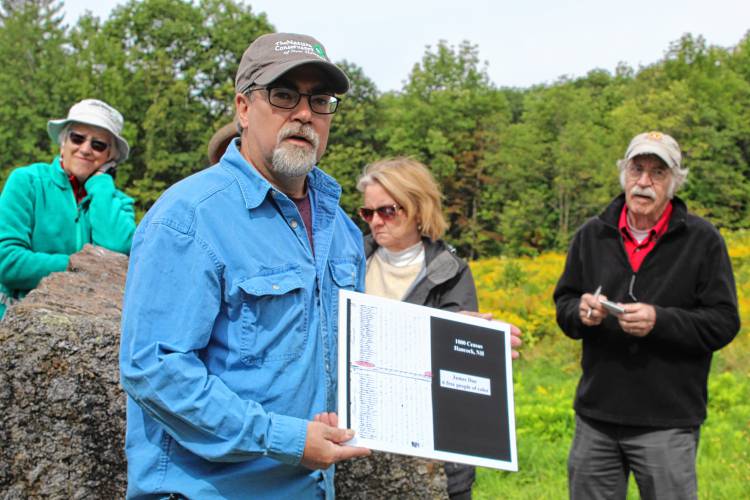Monadnock Ledger-Transcript
On Sunday, Eric Aldrich told tales of Hancock’s first black family – their personal scandals, which became public scandals through church admonishments, the troubling burial of Elliot Due, and the factions of town torn over the anti-slavery movement. The story makes up the fabric of a new piece of a black heritage tour previously only offered in Portsmouth.
No pictures remain of the Hancock’s first black residents, James Due and Jack Weare, or either of Due’s children. What little remains of their lives is mostly taken from church records and census records of the day, some of which is inaccurate, and all of which is colored by the perspective of those recording the records, explained Eric Aldrich of Hancock.
Aldrich has been researching Hancock’s first black residents, gathering what stories remain of them, and presented their tale during a tour of sites as part of a Black Heritage Trail of New Hampshire tour on Sunday. Hancock will be the second New Hampshire town with a Black Heritage Trail, following Portsmouth.
The trail begins where the Dues began: The family homestead, located in what is now known as the Welch Family Farm and Forest.
James Due
In 1790, James Due and Jack Weare came to Hancock, and built a house on what is now known as the Welch Farm.
Weare was an older man, apparently unrelated to Due, and little is known about either man, explained Aldrich. Weare was a former slave, and he and Due had a close enough relationship that Due gave the town 100 acres on the western side of Hancock for the support of Weare. They were likely farmers, as were most people in Hancock at the time.
“We know little about him. Where he’s from, these things are a mystery,” Aldrich said.
What little is known about James Due mostly comes from church records. Around 1790, James had a daughter with Hannah Davis, and a few years later, married her. While census records record the whole family as free people of color, it’s equally likely that Hannah was white, and was counted as the same race as her husband and children, explained Aldrich.
The marriage became a cause of strife with the church, when it was discovered Hannah had previously been married to Thomas Davis. While Hannah and her mother both testified to the church that Thomas Davis had released his wife from their marriage, the church, after several hearings on the matter drawing out several years, ejected her from the church.
James died in 1826, and likely lived in Hancock all his life.
The scandals of Betsey Due and Elliot Due
Hannah Due’s admonishment by the church wasn’t the last time the family would be brought before church discipline.
The Dues had two children, Betsey and Elliot. Betsey married Richard Razee, and moved to a farm only about a half mile from her parents.
Her brother, Elliot, married Lois French and moved to his own house on King’s Highway. He apparently had issues with alcohol, as in 1820, the Hancock Selectmen petitioned to have a guardian appointed for Elliot, as he wasn’t able to properly support his family due to over-indulgence of drink. Because of an inventory of his assets, records show that Elliot had little other than the basic furnishings of his home, with a cow and calf as the most valuable things to his name.
It was not Elliot and Betsey who became subject to the church’s displeasure, but rather their spouses, as it was “common knowledge” that Richard Razee and Lois Due were having an affair.
Razee left for New York, and even when he wanted to come back to his wife, she refused him. Both Betsey and Razee were excommunicated from the church, though Lois Due’s repentance was accepted and she was allowed to continue to be a member – at least until a few years later, when she was accused of having an affair with Betsey’s 15-year-old son, James.
The mysterious death of Elliot Due
Lois and Elliot remained married, despite their marital troubles, and eventually moved into a neighborhood on land that is now owned by the Harris Center for Conservation Education on the west side of Hancock.
Things seemed to turn around for Elliot. In 1828, he was no longer under guardianship, apparently having gotten sober, or to be doing well enough to support his family once again. But in April of 1843, he traveled to Dublin (now Harrisville) to purchas a half pint of gin. On his way home, he fell while crossing a stream.
He was found the next morning, on a Tuesday, and presumed dead. But by the time his funeral came on Friday, his countenance didn’t appear to be death-like, and the body was sweating profusely, causing some to question whether or not he was dead.
They buried him anyway.
Aldrich said he has sent accounts of Elliot Due’s burial to medical examiners around the state, who all came up with the same response: Dead bodies do not sweat.
“After a hard life, all these things with the church, it’s likely he was buried alive and that’s how his life ended,” Aldrich said.
Abolitionists in Hancock
In the 1840s, sentiments appeared to be torn in town, as a group of residents began to invite those heavily involved in the anti-slavery movement to speak and hold a convention in town – much to the displeasure of the church’s Rev. Archibald Burgess.
Burgess excommunicated six residents who invited the minister Henry C. Wright, a noted abolitionist who called for an immediate and if need be a militant end to slavery. That did not deter the group, and the year after, they organized an anti-slavery convention, with “all-star” speakers such as Nathaniel P. Rogers and Minister Parker Pillsbury, both of whom had edited the anti-slavery paper the Herald of Freedom, and Stephen Symonds Foster, who was known for speaking on the church’s complicity in slavery.
The convention was not popular with everyone, however.
“Young people disrupted the convention by rolling rocks to the pulpit, standing nearby, barking like dogs, clapping so that you couldn’t hear the speakers, throwing rocks at the building,” Aldrich said.
Ashley Saari can be reached at 924-7172 ext. 244 or asaari@ledgertranscript.com. She’s on Twitter @AshleySaariMLT.

